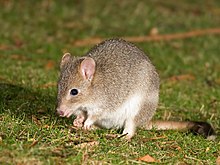Eastern bettong
| Eastern bettong[1] | |
|---|---|

| |
| Scientific classification | |
| Domain: | Eukaryota |
| Kingdom: | Animalia |
| Phylum: | Chordata |
| Class: | Mammalia |
| Infraclass: | Marsupialia |
| Order: | Diprotodontia |
| Family: | Potoroidae |
| Genus: | Bettongia |
| Species: | B. gaimardi
|
| Binomial name | |
| Bettongia gaimardi (Desmarest, 1822)
| |
| Subspecies | |
|
Bettongia gaimardi cuniculus | |

| |
| Present distribution of Bettongia gaimardi | |
The eastern bettong (Bettongia gaimardi), also known as the southern or Tasmanian bettong, is a small, hopping, rat-like mammal native to grassy forests of southeastern Australia and Tasmania. A member of the rat-kangaroo family (Potoroidae), it is active at night and feeds on fungi and plant roots. Like most marsupials, it carries its young in a pouch. The eastern bettong is under pressure by introduced predators and habitat loss. The subspecies on mainland Australia (B. g. gaimardi) is extinct, but populations of the Tasmanian subspecies (B. g. cuniculus) have been reintroduced there.[1][4]
The animal is called balbo by the Ngunnawal, an Aboriginal people who used to keep them as pets.[dubious – discuss]
Subspecies
[edit]Two formerly recognised species, Bettongia cuniculus (Tasmanian bettong) and Bettongia gaimardi (eastern bettong), were placed into a single species with two subspecies by Wakefield in 1967:[5][6]
- B. g. gaimardi, mainland subspecies (now extinct)
- B. g. cuniculus, Tasmanian subspecies
The introduction of the red fox and European rabbit to Australia led to the extinction of the mainland subspecies during the 1920s.[2][6] The Tasmanian subspecies still exists.[2]
In 2012, a small population was reintroduced to the mainland in Canberra.[7] The reintroduction to Mulligans Flat Woodland Sanctuary was successful, and led to further reintroductions using an on-site breeding program out of the nearby Tidbinbilla Nature Reserve and wild eastern bettongs translocated from Tasmania.[8]
Diet and behaviour
[edit]This animal's habitat is dry, open eucalypt forests and grassy woodlands at altitudes between sea level and 1,000 metres (3,300 ft).
A major component of their diet is truffles and other underground fungi, as well as roots and tubers. Insects and grubs are also eaten. It is unique in that it will travel up to 1.5 km (0.93 mi) from its nest to a feeding area, a considerable distance for such a small creature.[9]
A nocturnal animal, the bettong sleeps during the day in a domed nest. The nests are made with densely woven grass, leaves and shredded bark in a sheltered site such as a shallow depression in the ground or under a fallen log or clump of vegetation. The animal uses its curved prehensile tail to transport the nesting materials to the nest site.[9] The animal only uses the nest for one or two nights, before it moves on in search of food.
Like other bettongs, the eastern bettong is a continuous breeder, producing young throughout the year.[10] The gestation period is 21 days, after which the infant (referred to as a "joey") remains in the pouch for an additional 105 days.
Threats
[edit]While the mainland population became extinct in the 1920s,[2][6] the Tasmanian population has remained secure.[2] One concern is that most of the bettongs are found on private land, with only two groups found within reserves. Red foxes are a major threat.[11][12] The International Union for Conservation of Nature has raised the threat status for eastern bettongs from least concern to near threatened.[2]
References
[edit]- ^ a b Groves, C. P. (2005). Wilson, D. E.; Reeder, D. M. (eds.). Mammal Species of the World: A Taxonomic and Geographic Reference (3rd ed.). Baltimore: Johns Hopkins University Press. p. 57. ISBN 0-801-88221-4. OCLC 62265494.
- ^ a b c d e f Burbidge, A.A.; Woinarski, J.; Johnson, C.N. (2016). "Bettongia gaimardi". IUCN Red List of Threatened Species. 2016: e.T2783A21960911. doi:10.2305/IUCN.UK.2016-1.RLTS.T2783A21960911.en. Retrieved 12 November 2021.
- ^ "Appendices | CITES". cites.org. Retrieved 2022-01-14.
- ^ Rose, R. (1997). Metabolic rate and thermal conductance in a mycophagous marsupial, Bettongia gaimardi. Archived 2008-07-23 at the Wayback Machine The World Wide Web Journal of Biology 2: 2-7.
- ^ Wakefield, N. (1967). Some taxonomic revision in the Australian marsupial genus Bettongia, with description of a new species. The Victorian Naturalist. 84:8-22.
- ^ a b c Department of Sustainability, Environment, Water, Population and Communities (2011). Bettongia gaimardi gaimardi in Species Profile and Threats Database, Department of Sustainability, Environment, Water, Population and Communities, Canberra. Available from: http://www.environment.gov.au/sprat. Accessed Thu, 29 Dec 2011 06:51:31 +1100. (http://www.environment.gov.au/cgi-bin/sprat/public/publicspecies.pl?taxon_id=66656)
- ^ ABC News Rare marsupials found fat and happy in new home http://www.abc.net.au/news/2013-01-20/marsupials-found-fat-and-happy-in-their-new-home/4472690
- ^ "Eastern Bettong Reintroduction". www.mfgowoodlandexperiment.org.au. Retrieved 2020-04-16.
- ^ a b Department of Primary Industries and Water (August 2006). [1] The Tasmanian bettong]. Department of Primary Industries and Water.
- ^ University of Tasmania, School of Zoology. [2] Archived 2009-09-15 at the Wayback Machine Profile – Tasmanian Bettong]. University of Tasmania.
- ^ Department of Primary Industries and Water - Foxes in Tasmania http://www.dpiw.tas.gov.au/inter.nsf/ThemeNodes/LBUN-5K438G
- ^ Foxes in Tasmania-Invasive Animals CRC Report http://www.dpiw.tas.gov.au/inter.nsf/publications/lbun-6r26gg?
External links
[edit] Media related to Bettongia gaimardi at Wikimedia Commons
Media related to Bettongia gaimardi at Wikimedia Commons Data related to Bettongia gaimardi at Wikispecies
Data related to Bettongia gaimardi at Wikispecies

